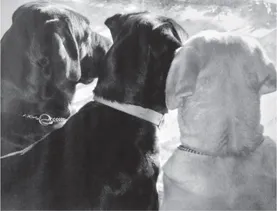![]()
Chapter 1
FROM SNOW PATTERNS TO HUMAN PATTERNS: THE ESSENCE OF DYNAMIC TRICKY MIXES
As I write these words, I enjoy sitting in my study, high up in a remodeled old farmhouse at our Pennsylvania farm, “Eagle Spirits Farm.” It is early March 2021, and we have already experienced several snowfalls and snow melts. When I glance outside, I view meadows still partially covered with snow.
Below, I will include some snow-related photographs, which reveal the dynamic processes that are central to this book.
First, though, reflect on how difficult snow predictions and other weather details continue to be for scientists. Why, in this day and age, despite extensive technologies worldwide—technology that continually monitor temperature, humidity, winds, clouds, and more—and despite fast computer matrices and thousands of trained weather scientists, can the models not tell me more precisely when the meadows here at the farm will get snow and how much?
The answer lies partly in the highly complex, highly dynamic, and rapidly changing mix of conditions that feed into current weather any place on earth and then feed future weather patterns. Dynamic systems are at work, for sure.
We emphasize the trickiness that emerges, not only for weather predictions but for patterns of human planning and action. It becomes tricky to discover an accurate account of what the current mix of conditions and their dynamic interplay are and whether they are leading into new snowfall on our meadows in the near future. So, both understanding the current dynamic patterns and predicting future patterns turn out to be prone-to-error, complex, and elusive—in short, tricky. The same cautions apply to the attempts we make to create better action plans, procedures, collaborations for teaching children, rehab strategies for adults, the composition of art, music, and dance choreography, global warming and pollution controls, reductions in inter-group strife, and all other domains.
Sometimes, the particular dynamic tricky mixes we launch prove to have negative effects rather than the positive outcomes we hope for or expect. However, by maintaining a continual awareness of the complexity and trickiness of dynamic processes, we place ourselves in much better positions to make new analyses and revised plans, to move beyond failures to new, highly successful dynamic positive creative mixes. The many discussions, events, and phenomena within this book are intended to lead you and others to increased awareness, the discovery of a rich new set of strategies and experimental moves, and exciting new progress on your agendas in any domain.
Now, consider a maxim that sums up much of what you will encounter and can apply in your own life.
Dynamic tricky mix thinking calls attention to greater complexities in the dynamics of situations than what is usually considered. In turn, given such heightened awareness and understanding of the dynamics in place, there are greatly-enhanced possibilities for individuals and groups to create highly engaging and highly successful new pathways. “Tricky” new “mixes” of strategies, partners, social connectedness, careful and valid monitoring of progress, and dynamic adjustments, or “re-mixes,” emerge and dramatically transform the rate of progress toward key goals.
Next, let’s return to the natural world and the dynamic patterns concerning snow.
In this spirit, explore the photographs of snow below. Take note of what you see in them, and then read my commentary following them.
Melting Snow Patterns, Puzzle One—What Do You See?
Melting Snow Patterns, Puzzle Two—What Do You See?
If you saw more than “just snow” in these pictures, you were using a cognitive ability that has shown its power repeatedly, across nearly two million years. It’s the ability to re-interpret what we see, assessing it as more than the usual, familiar, literal object or event before us in a scene. In every sense, there were no ghosts or dragons or dogs in the snow scenes I just shared from our local environment, our Eagle Spirits Farm. You own whatever creatures your mind generated in response to these shots of simple, everyday snow that is in the process of slowly melting away.
A more simplistic view is that our land here was covered with two inches of snow, which gradually and smoothly declined to almost nothing, then to no snow at all.
Complex dynamic systems, however, were in play all through the week. First, when the snow fell, it did not deposit evenly. Instead, for each patch of ground, the amount received was influenced by a tricky mix of local air temperatures, wind shifts, and uneven ground surfaces, including the presence of rocks and sticks and tufts of grass. Similarly, each day after the snowfall, the speed and pattern of melting snow led to the emergence of particular patterns in the newly exposed ground and in the remaining snow. These would have been exceedingly tricky to predict before their occurrence. Among the tricky mix of dynamic conditions converging would be at least these: the size and warmth of the rocks beneath the snow, the warmth of the bare ground, the local air temperature, any swirls of wind, the angles of the sun and the clouds obscuring the sun at times, and how the temperature of the ground (already revealed) influenced the temperatures across patches of remaining snow.
As the snow comes and goes with dynamic complexity, so goes all aspects of our individual and cooperative efforts. Further, so goes the interplay of complex tricky mix conditions in nature and human relationships with nature.
You are invited to go beyond any comparisons, interpretations, and conclusions that I draw in these further chapters, ones that traverse seemingly dissimilar experiences, events, players, and situations. Please generate and carry into your future endeavors new insights into the wonders and frustrations of highly complex dynamic systems and new action plans for creating positive tricky mix solutions.
![]()
Chapter 2
ASSORTED EYE-OPENERS
Imagine a better future. What would you like to see enhanced in your own life and society and the world at large?
The processes for creating change are strikingly similar, regardless of the topic or whether one, a few, or millions of individuals are affected. In all cases, too-simplistic approaches, overconfidence, premature conclusions, and “sacred cows” must be avoided.
Consider our Family Dog Sail
Sail was a spirited, chunky, lively golden Labrador retriever. She was lucky to live on a farm and chase rabbits and groundhogs, relishing long walks in the woods. Sail personified strength and energy, bulldozing through snow or bushes or dirt or any other obstacle to get where she wanted to go. This beautiful and muscular family member loved our farm and her active life.
Then, quite suddenly but with age, her agility and strength seemed to disappear. Sail could no longer hop into our car for a ride or even walk up the steps to the farmhouse porch. It seemed for a while that her active life was over and that we might very well end up hauling her around in a trailer behind a small tractor so she could visit the ponds or the woods.
One simple—and ultimately incorrect explanation—was that her joints and muscles were just too worn out to ever function well again. One dead-end treatment was the provision of the single aging-dog supplement, glucosamine. This made her lose a little weight, but her weight was not the critical variable.
It turned out that a more complex solution, a more complex “mix” of components, made all the difference. Once we started her on this new mix—just a few days later and for years afterward—Sail could again climb the stairs, make the long hikes, and chase the ever groundhog she wanted. She was not hopelessly physically damaged nor did she need surgery of any kind; that was proved by her rapid recovery.
Reader alert. Are you able to guess what new mix brought Sail into recovery?
The right “tricky mix” for our beloved lab was borrowed straight from college campuses and rehab clinics, where strategies for athletes with sprains and tears of muscles and ligaments and tendons reign: Sports Complex pills consisting of relatively high doses of three components rather than just one component, namely glucosamine plus MSM plus chondroitin. Since another one of Sail’s traits was to gobble just about anything thrown her way, it was child’s play to get her to start taking these pills.
Drum roll—bam, ba bam, ba bam, bam, bam!
Three days later, our old Sail was back—climbing stairs, hopping into the car, frolicking on hikes, and eagerly chasing rabbits. And as she became more active week by week, that exercise further fed into her strength and recovery program. What a relief!
This almost miraculous recovery demonstrated several aspects of “dynamic mixes” as a route to new progress. For Sail, her recovery proved that she was not too worn down physically and not suffering from some degenerative illness. Her body was still “ready” for an active, engaged life, but this readiness was not evident until a new combination of conditions was dynamically mixed with her ongoing eating and exercise patterns and her physical, physiological makeup.
Our dogs, Skye, Banjo, and Sail, each of which got stuck—aged and lost mobility—and then recovered quickly with a Dynamic Re-Mix of nutrition.
Illusions of Complete Analysis and Perfect Planning
Other instances of dynamic mix processes highlight the fact that even when extraordinary efforts have been maintained for long periods, an effective mix is not guaranteed to emerge. I was in a Minnesota school, hoping that my research lab’s efforts to create a new mix of software and teacher strategies would pay off in dramatic gains for poor readers in elementary school when the Challenger space mission blew up soon after liftoff. Much more to come about children’s learning . . .
For now, consider the Challenger disaster as a case study in the complexity of mixes when large teams of skilled professionals work toward a fail-free technological accomplishment. All of the Challenger spaceship’s systems and all of the required rocket technology that boosted it into a high orbit were checked and rechecked with multiple backups and alerts. Nevertheless, it blew up.
Large and numerous committees found the whole disaster puzzling. Failure should have been precluded by the extensive planning and backups, the fail-safes. Into this morass steps the physicist Richard Feynman. He, as an outsider to the project attending a dinner event that brought experts together on the matter, used a rubber band and a glass of ice water to demonstrate that the likely critical variable was temperature and its effects on the flexibility and density of the rubber seals between rocket stages. The whole orderly yet complex sequence became a deadly negative tricky mix when the temperature in Florida at launch time was significantly colder than any testing and simulations had covered. The seal failed and fed the dynamic mixtures for a catastrophic explosion. As an outsider to the whole project, Feynman was an active and creative thinker and had quickly ferreted out the relevant causative mix behind the surprising disaster.
Breaking into Words from the World of Autism
We can see in examples of children’s learning the same dynamic processes at work. Some shifts in learning incorporate radical, surprising changes in context. This proved true for one boy with autism, Tommy.
He had been given countless behavioral trials calling attention to a single word, such as “cookie.” Any correct attempt at using the word would receive an immediate reward in this procedure, whether stars or candy or other items. Years of training did not produce results: this boy, nine years old, used almost no spoken words in ordinary conversation. He still had not learned the word cookie, even after more than 10,000 trials.
In a radical change of approach, his therapists decided to seek his engagement in varied contexts to determine if he would spontaneously ask for the name of something interesting, which he had spotted. On a California beachside sidewalk, sure enough, he noticed the word “sidewalk” painted on the sidewalk. He asked, “What’s that?” through gestures, and his therapist, delighted by the communication, said, “sidewalk.” The boy’s first attempt was a weak imitation, but the therapist encouraged him further by saying, “That’s, right . . . sidewalk.” Bingo! On his second attempt, he accurately said the word sidewalk.
With a tricky new mix of exploration, encouragement to show interest and initiative, the escape from a training situation and environment with a long history of negative emotion, and newly positive emotional engagement from both child and therapist, two trials worked marvelously. Later in this book, we will encounter many similar instances for positive changes in individuals, organizations, and varied groups.
A Fishing We Will Go
And now a fishing tale or two. When my daughter was two and a half years of age, we regularly visited a nearby lake to go fishing. My first goal was to introduce Leilani to the mysteries of the lake, forests, and all of the natural world. A simple strategy would have been to just sit on the shore and wait to see if fish would surface, if ducks would swim by, if red-tailed hawks would circle, and so on. But we chose the more complex approach of doing all that vigilant watching combined with a hook plus a worm plus a floating bobber fish-biting indicator. Now, we had many pieces of a truly positive, excellent tricky mix. We were in a position to secure a fabulous mix.
As we continue in any context and activity, there is the potential to build up an increa...



